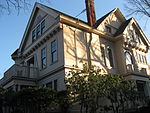Gaston–Strong House
1892 establishments in OregonA. E. Doyle buildingsArts and Crafts architecture in OregonGoose Hollow, Portland, OregonHouses completed in 1892 ... and 5 more
Houses on the National Register of Historic Places in Portland, OregonIndividually listed contributing properties to historic districts on the National Register in OregonNRHP infobox with nocatPortland Historic LandmarksStick-Eastlake architecture in Oregon

The Gaston–Strong House is a house located in southwest Portland, Oregon listed on the National Register of Historic Places. An early resident was Joseph P. Gaston.
Excerpt from the Wikipedia article Gaston–Strong House (License: CC BY-SA 3.0, Authors, Images).Gaston–Strong House
Southwest King Avenue, Portland Goose Hollow
Geographical coordinates (GPS) Address Nearby Places Show on map
Geographical coordinates (GPS)
| Latitude | Longitude |
|---|---|
| N 45.520027 ° | E -122.69518 ° |
Address
Southwest King Avenue 1130
97205 Portland, Goose Hollow
Oregon, United States
Open on Google Maps









